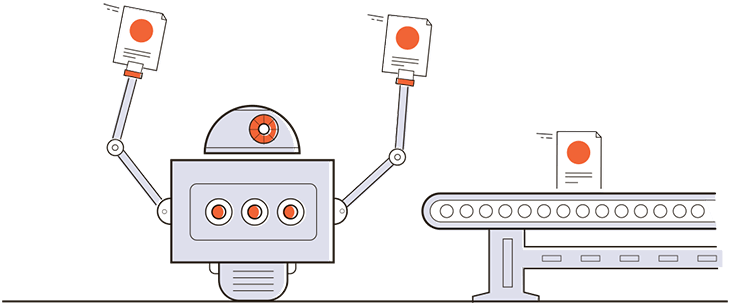
Robotic Process Automation (RPA) is an excellent complement to workflow automation by offloading rote, manual tasks to bots.
Separate but Compatible Tools
Workflow automation and robotic process automation (RPA) are separate but compatible technologies. Workflow automation tools like Nutrient Workflow allow your business to define a series of tasks involved in a process and ensure the correct individuals complete them in a standardized, compliant manner.
RPA digs deeper into a specific type of task performed as part of a workflow. Tasks frequently addressed by RPA systems involve the tedious process of taking data out of one system or document and entering it into another system. This is especially helpful when there is no API connecting the different methods. In addition, RPA systems can “learn” how to perform rote tasks by observing them and using AI to design rules based on actions taken.
RPA Example: Invoice Email Inbox Monitor

Let’s say an administrative mailbox regularly receives invoices as PDF attachments. As part of the task workflow, someone must check the mailbox, open the PDF attachment, ensure the invoice is completed correctly, and then send it to the appropriate finance staff for processing.
Instead, an RPA tool can process all these incoming invoices. A bot can check for new emails, open them, and open the attachments. It then uses rules to determine if the invoice is compliant. If the invoice has an issue, the bot signals the workflow automation system to trigger an automated workflow.
All this happens in seconds and frees up the employee who spent their day reviewing emails and attachments to work on more valuable tasks.
How RPA and Workflow Automation Work Together
It’s helpful to view RPA activities as tasks within a broader workflow. Consider the example above.
Now let’s say once this RPA task is completed, several more human tasks need to be performed. For instance, someone in purchasing needs to review the data that’s been entered to approve it. Once approved, the data must trigger alerts for fulfillment with another department. The bot passes all the data it extracted from the invoice and passes it into the workflow. Logic in the workflow system evaluates the data from the invoice and assigns a task (and possible additional workflows) for someone to review/resolve the issue.
These approval and follow-up tasks can be handled by an automated workflow triggered when the RPA task completes.

Nutrient Workflow and RPA
While Nutrient Workflow is not an RPA tool, it is compatible with any RPA tool on the market. Integration can be done through our API or via the front end. Our philosophy is that you should choose the best RPA vendor for your needs and then pair it with Nutrient Workflow’s powerful workflow automation tools.
Top RPA Vendors
Want to Discuss RPA and Workflow Automation?
If you’re intrigued about how RPA combined with workflow automation can help your organization become even more efficient and productive, please contact us.






